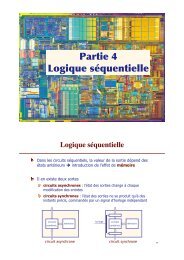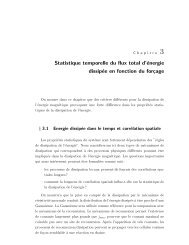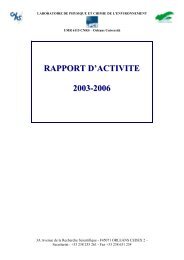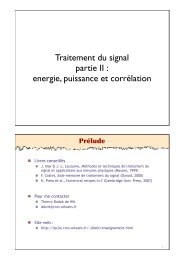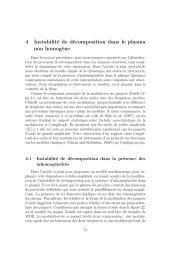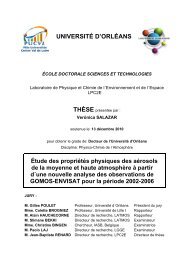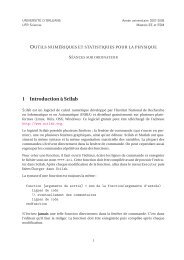UNIVERSITÉ D'ORLÉANS - Laboratoire de physique et chimie de l ...
UNIVERSITÉ D'ORLÉANS - Laboratoire de physique et chimie de l ...
UNIVERSITÉ D'ORLÉANS - Laboratoire de physique et chimie de l ...
You also want an ePaper? Increase the reach of your titles
YUMPU automatically turns print PDFs into web optimized ePapers that Google loves.
VSLS of about 0.05–0.10 ppbv (or 50–100 parts per trillion by volume (pptv)) to stratospheric<br />
chlorine and <strong>de</strong>monstrate the need for more accurate HCl measurements (WMO, 2007) or a<br />
more direct <strong>de</strong>termination of the abundance of VSLS in the upper troposphere and lower<br />
stratosphere.<br />
In the light of observed and predicted <strong>de</strong>creases of anthropogenic ozone-<strong>de</strong>pl<strong>et</strong>ing long-lived<br />
substances regulated by the revised Montreal Protocol, it is important to quantify the<br />
contribution of the VSLS to the chlorine loading in the stratosphere, both from anthropogenic<br />
origin (but without regulation until now) and from natural origin (in a changing climate which<br />
should be favourable to emission increase). The uncertainty in the amount of VSLS reaching<br />
the stratosphere is due to the high chemical reactivity of these species in the troposphere<br />
leading to short lif<strong>et</strong>imes (from hours to a few months) with respect to transport time to the<br />
stratosphere, and to the paucity of the measurements in the tropical tropopause layer (TTL),<br />
the main entrance region of the chemical species into the global stratosphere. In the last<br />
WMO report (2007), a VSL SGs contribution of 55±3 pptv to the chlorine budg<strong>et</strong> has been<br />
estimated in the upper tropical troposphere (> 10 km height) including the TTL. Since then,<br />
Laube <strong>et</strong> al. (2008) have confirmed this result, with a chlorine vmr estimated to 49±6 pptv at<br />
15.2 km, resulting from their VSL SGs measurements and an additional contribution of 1.5<br />
pptv from chloro<strong>et</strong>hane (WMO, 2007). These authors performed simultaneous measurements<br />
of CH2Cl2 (11.2 pptv), CH2ClCH2Cl (6.2 pptv), CHCl3 (2.7 pptv), C2Cl4 (1.0 pptv) and other<br />
very minor contributors to chlorine vmr during a balloon flight in the tropics (near Teresina,<br />
Brazil, 5.0°S–42.9°W).<br />
In or<strong>de</strong>r to fully quantify the VSLS contribution to total inorganic chlorine in the stratosphere,<br />
one must also inclu<strong>de</strong> the intermediate and final product gases (PGs) from VSLS <strong>de</strong>gradation<br />
injected into the stratosphere. Phosgene (COCl2) is the main intermediate product present in<br />
the upper troposphere, resulting from the <strong>de</strong>gradation of VSL SGs, since its lif<strong>et</strong>ime is much<br />
longer than any other intermediate products (WMO, 2007). The last WMO report (2007),<br />
based on the work of Toon <strong>et</strong> al. (2001), indicates a COCl2 vmr of 22.5±2.5 pptv, i.e. 45±5<br />
pptv of chlorine, from measurements of the MkIV balloon-borne instrument performed in the<br />
latitudinal zone 34–68°N, b<strong>et</strong>ween 1992 and 2000. Phosgene is also produced by long-lived<br />
SGs so that the total VSLS contribution to stratospheric chlorine in the form of organic<br />
species (SGs and intermediate PGs) ranges b<strong>et</strong>ween about 50 and 100 pptv according to<br />
WMO (2007). The COCl2 vmr values should be adapted for tropical latitu<strong>de</strong>s and updated by<br />
more recent ones. Fu <strong>et</strong> al. (2007) recently performed COCl2 measurements using the ACE-<br />
112



